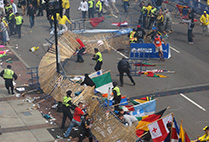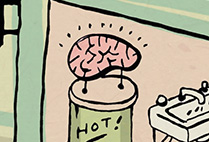Last February’s atmospheric blowup of a meteor over Russia injured 1,500 people, mostly from glass smashed by the blast, whose force was estimated at 30 times that of the atom bomb dropped on Hiroshima in 1945. A month later, the US Senate heard former astronaut Edward Lu advocate for beefing up asteroid detection and warning that the casualties in Russia would have been incalculably greater had the meteor exploded closer to a big city. The Russian rock, a NASA scientist said at the hearing, snuck by Earth’s telescopes, whose sights are set on projectiles much larger than that 60-foot-diameter meteor.
Is NASA worried? Sufficiently so that it has announced an asteroid Grand Challenge, inviting ideas from the global scientific community about how to spot and stop asteroids that threaten our planet. (Grand Challenges are defined by the White House Office of Science and Technology Policy as ambitious goals on a national or global scale that capture the imagination and demand advances in innovation and breakthroughs in science and technology.)
At Boston University, our sky-gazing capabilities include a partnership with the $50 million Discovery Channel Telescope, at the Lowell Observatory in Arizona, as well as the Perkins Telescope, at the same site. But even the Discovery Channel equipment, which doubled the distance in space that astronomers could see, is not an asteroid watchdog per se.
You might pick one up, but that’s not what you’re intending to look for,” says W. Jeffrey Hughes, a College of Arts & Sciences professor of astronomy and an associate dean. “And you’re unlikely to pick up one of the very small ones, because it requires, essentially, a long time exposure.”
Jeffrey Hughes explains how we might use rockets to save the Earth from an asteroid impact by pushing back.
How exactly does one stop an asteroid? First, Hughes says, we should distinguish between planet-killers—asteroids so massive that we could kiss our posteriors good-bye—and smaller, potential city-killers like the Russian meteor. The former, he says, are hard to miss. Current scopes pick up 95 percent of those believed to be lurking near us, none of which currently threatens Earth, and improved technology will move that detection rate closer to 100 percent. Hughes and Andrew West, a CAS assistant professor of astronomy, concur that strikes from such monster rocks happen only once in tens of millions of years.
Jeffrey Hughes explains how lasers may one day save the planet from an asteroid doomsday scenario.
City-killers, on the other hand, the asteroids small enough to go undetected by telescopes, strike once every 1,000 years. That sounds disturbing, but Hughes points out that “tsunamis, super storms, and major earthquakes also can come close to obliterating cities or even small countries, and they happen far more frequently.” It’s better to invest in preparing for those more likely catastrophes, he says. “I don’t think detecting small asteroids should be a NASA priority.”
But Hughes also knows that human nature is easily frazzled by even the most unlikely events. “Tell people about a risk they’ve never heard about or thought about,” he says, “and they get excited.”
Obviously, says the astronomer, the best scenario would provide lots of warning—“ideally a decade or more”—of a coming collision, and he thinks such lead times are becoming possible as scientists’ ability to calculate orbits improves. The really hard part, he says, is figuring out what to do once the heavenly threat is identified. Hughes’ preferred approach would be to knock it off course by hijacking its steering. He proposes landing a spacecraft equipped with an engine propulsion system on the asteroid. “Then we can switch on the engine,” he says. “A low continuous-thrust engine, such as an ion propulsion engine that can get its energy from solar cells, is the most efficient for this kind of task. Not very dramatic, but effective.”
Punching the asteroid off course by shooting an object into it—one option mentioned at the Senate hearing—might work, says Hughes, but it won’t be easy to fire a missile that has enough momentum to do that. Another possibility would be hitting the object with a radar beam to heat up one side, causing it to release more gas and veer slightly off course.
In the opinion of astronaut Lu, the menu of choices makes deflection easier than detection. “The key,” Lu told a Senate committee, “is if you don’t know where they are, there’s nothing you can do.”













































Related Stories
Klamkin Receives NASA Early Career Faculty
Recognized for efforts to improve deep space communication
ENG Prof Wins NASA Early Career Faculty Award
Given for developing deep space communication technology
Where Did Mars’ Water Go?
BU astronomer contributes to new findings by NASA’s MAVEN
Post Your Comment